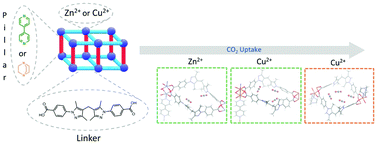Modulation of CO2 adsorption in novel pillar-layered MOFs based on carboxylate–pyrazole flexible linker†
Abstract
Metal–organic frameworks (MOFs) have attracted significant attention as sorbents due to their high surface area, tunable pore volume and pore size, coordinatively unsaturated metal sites, and ability to install desired functional groups by post-synthetic modification. Herein, we report three new MOFs with pillar–paddlewheel structures that have been synthesized solvothermally from the mixture of the carboxylate–pyrazole flexible linker (H2L), 4,4-bipyridine (BPY)/triethylenediamine (DABCO), and Zn(II)/Cu(II) ions. The MOFs obtained, namely [ZnII(L)BPY], [CuII(L)BPY], and [CuII(L)DABCO], exhibit two-fold interpenetration and dinuclear paddle–wheel nodes. The Zn(II)/Cu(II) cations are coordinated by two equatorial L linkers that result in two-dimensional sheets which in turn are pillared by BPY or DABCO in the perpendicular direction to obtain a neutral three-dimensional framework that shows one-dimensional square channels. The three pillar-layered MOFs were characterized as microporous materials showing high crystalline stability after activation at 120 °C and CO2 adsorption. All MOFs contain uncoordinated Lewis basic pyrazole nitrogen atoms in the framework which have an affinity toward CO2 and hence could potentially serve as CO2 adsorption material. The CO2 uptake capacity was initially enhanced by replacing Zn with Cu and then replacing the pillar, going from BPY to DABCO. Overall, all the MOFs exhibit low isosteric heat (Qst) of adsorption which signifies an advantage due to the energy required for the adsorption and regeneration processes.



 Please wait while we load your content...
Please wait while we load your content...
